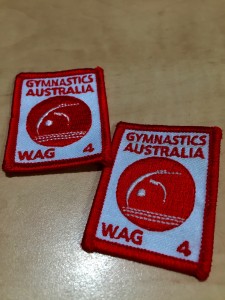The School Dog – Chester the Wonder Dog
 ‘Hi my name is Chester. I am a cute and cuddly Golden Retriever and I have lots of hair, that makes me very hot in the summer time. I go to the vet often and have had lots of needles to make sure I am healthy. My owner has taken me to lots of classes and they have helped me to become ‘obedient!’
‘Hi my name is Chester. I am a cute and cuddly Golden Retriever and I have lots of hair, that makes me very hot in the summer time. I go to the vet often and have had lots of needles to make sure I am healthy. My owner has taken me to lots of classes and they have helped me to become ‘obedient!’
I recently had my 4th birthday. My owner says I have now officially grown out of my ‘puppy stage’ and I am now responsible and patient enough to help children.
I love to have my ears and tummy rubbed and especially like it when I get brushed.
I will sit and shake hands on command, but am yet to master rolling over. I am great at running after balls and sticks i
I feel like it, but sometimes I am a bit lazy and ‘forget’ to bring them back to people! Everyone says I am ‘cute’ and so ‘placid.’ I am not sure what ‘placid’ means, but I think it is a good thing as they say it in a nice way.
I love visiting Hackham East Primary School on Monday and Fridays. I am now the school dog. When I am at school I stay in the office and sometimes I visit classrooms if I am invited. When I am not guarding Mr Thiele, Ms. Sally and Mr Megson’s offices I get to listen to kids read, or sometimes they come down to visit me and give me a tummy scratch or tell me to sit and shake hands. I like it when the children come to visit me as otherwise I just have to listen to boring meetings in-between napping and my guard doggy duties. Sometimes I get to visit the staff room and see the ‘big people’ at school. I like this, but sometimes they say my name in a high-pitched screech, but that is OK because then they grab me and try to kiss me. I LOVE my job. – Written by Chester and assisted with the typing by Sally Slattery. (When will Apple invent an iPawd for dogs?)
I am definitely not a “doggy” person, nor a cat fan. My three kids have been pestering for a dog for years. I gave them fish in aquariums. Nothing has changed my mind about dogs… yet.
Last year I attended my first SAPPA Conference where scientist and inspirational speaker, Matt Church, began his session with a photo of his two kids with the family dog and an almost throw away comment about how every child should have a dog due to the health benefits of having dogs as support in the family and workplace to foster empathy, nurture, care and positive wellbeing.
Just prior to this, Sally Slattery, Deputy Principal and inspirational educator, had visited for a weekend work meeting and brought Chester, a golden retriever to be doggy-sat by my kids. Apart from leaving a “calling card” in the garden, I was impressed by the affinity he had with my children who wanted to cuddle, pat and play with him until he flaked on the door mat, exhausted by the attention.
Following the SAPPA Conference, I asked Sally what she thought of the idea of Chester becoming the ‘school dog’. His J&P (or is it J&D?) specifications would be negotiated but would involve being read to, being available to be patted, scratched and cuddled by a range of children who may even be anxious, angry and troubled, and to be taken for the occasional walk. Sally immediately embraced the idea.
We presented a proposal for a School Dog to the Governing Council, who to our surprise was overwhelmingly supportive. They had one stipulation that Chester attend every Council meeting!
Chester the Wonder Dog visited for a day for an interview and an audition to see if he was the ‘dog for the job’. He passed with flying colors! He was an immediate hit with staff, children and parents. He had so much attention that at times he needed to take himself away to curl up in a secluded spot to sleep.
He now knows that he works Mondays and Fridays and waits excitedly in the mornings at the front door for Sally to let him in the car for the trip to work. On arrival, once out the car, he does the obligatory sniff around the front garden and then bounds into the staffroom and offices to say hello to everyone. He shares an office with Sally and freely roams around the administration areas. He only goes into the yard on a lead with responsible students and adults, at appropriate times.
He has been on extensive and ongoing visits to classrooms to teach children how to be with Chester to ensure safe handling, so that they are familiar with appropriate ways to interact and also to support timid students gain confidence when he is around.
Students have done a risk benefit assessment. The benefits are immense. The perceived risks have become learning opportunities.
Chester – Risk Benefit Assessment
| Benefits/Positives |
Perceived Risks |
- Helping students calm down
- He makes children happy
- Teaches children to care for others
- It is great to pat Chester when I am escalating with my choices
- Makes me happy
- Taking Chester for walks help me to make strong choices because its only something you can do if you are going to be responsible
- He is welcoming and friendly
- He makes me feel more comfortable with my own bad haircut.
|
- Pulling Chester’s tail and making him upset
- Some students tease him with food and then take it away from him
- He eats from bins
- Calling his name and then walking away from him when he obeys a command
|
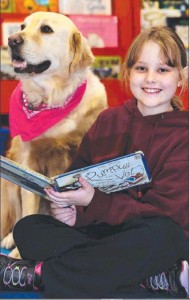 Each class has a Chester Card which is brought down with individuals or pairs of children for 5 minutes of Chester Time. The cards list the positive things children can do with him and how.
Each class has a Chester Card which is brought down with individuals or pairs of children for 5 minutes of Chester Time. The cards list the positive things children can do with him and how.
Parents and caregivers understand that Chester is trained to be a support dog and has authorisation to be on school grounds. No other pets, including dogs and cats can be on school grounds without permission.
There is an abundance of research around the health, stress and wellbeing benefits of having dogs in different workplaces and care systems. Many workplaces are now exploring the benefits of having a workplace pet or dog to help reduce stress and increase happiness and positive wellbeing.
Research shows:
- Interactions with therapy animals can decrease stress in humans
- Playing with or petting an animal can increase levels of stress reducing hormones leading to children (and adults) feeling more relaxed and calm
- They can help to reduce anxiety, tiredness and provide emotional support
- Animals help to build responsibility and empathy in children
Positive benefits we have already seen through Chester’s interactions with students and adults have been –
- The calming effect he has had on several children who were angry, upset or heightened – they calmed much more quickly by patting Chester and we were then able to help them discuss the problem and discuss ways to positively re-engage back in the classroom
- Providing a positive reinforcement for students who always do the right thing in class – they have been able to come down and spend a short amount of positive time interacting with Chester in the office
- Supporting some of our students to have a positive start to the day – they come and say a quick hello to Chester on the way to class
- A positive impact on staff happiness and wellbeing – he puts a smile on their face and they love popping by to give him a quick pat
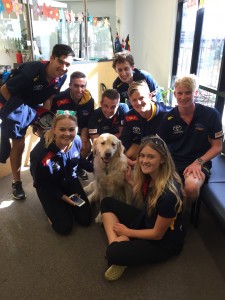 Chester is now a popular and valued member of staff. He has his favourites and will often be found lying at Lee’s feet in the front office or following Jae around knowing that she will eventually give in and feed him some of her lunch. And speaking of lunch, Chester hoovers around the staffroom finding any morsels of feed that may have landed on the floor and twice has managed to remove my lunch from my bag and eat every bit, including the wrapping. I have forgiven him … just.
Chester is now a popular and valued member of staff. He has his favourites and will often be found lying at Lee’s feet in the front office or following Jae around knowing that she will eventually give in and feed him some of her lunch. And speaking of lunch, Chester hoovers around the staffroom finding any morsels of feed that may have landed on the floor and twice has managed to remove my lunch from my bag and eat every bit, including the wrapping. I have forgiven him … just.
Everyone loves Chester the School Dog. Including me.
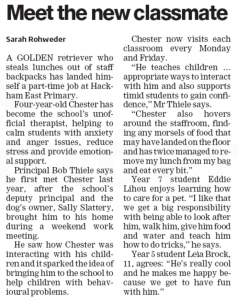
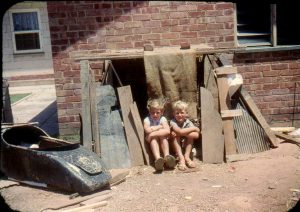 As a child, I used to build the best cubby houses with my sister, Julie. We would collect anything that could be useful to construct the most elaborate structures. We would not always agree on our designs and would occasionally argue about what should go where and what the cubby was for -a fort, a hideout, a doll’s hospital, etc. We would spend a little time playing our make believe games in them and then deconstruct to build something more elaborate. Sometimes our cubbies fell down on top of us. Luckily there were not too severe injuries.
As a child, I used to build the best cubby houses with my sister, Julie. We would collect anything that could be useful to construct the most elaborate structures. We would not always agree on our designs and would occasionally argue about what should go where and what the cubby was for -a fort, a hideout, a doll’s hospital, etc. We would spend a little time playing our make believe games in them and then deconstruct to build something more elaborate. Sometimes our cubbies fell down on top of us. Luckily there were not too severe injuries.

 Imagine you never letting go. Your child would never learn to swim and would always be dependent on you when in the water. Not letting go could put your children eventually in mortal danger of drowning if you are not around.
Imagine you never letting go. Your child would never learn to swim and would always be dependent on you when in the water. Not letting go could put your children eventually in mortal danger of drowning if you are not around.



